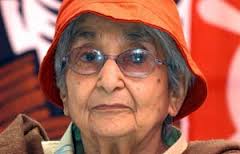
Kanpur, July 23: Lakshmi Sehgal, a close associate of Netaji Subhas Chandra Bose and the first head of the women's wing of the Azad Hind Fauj, died around 11.20 a.m. Monday at a private hospital in Kanpur, her family said. She was 97.
She was in coma for the past three days after suffering a massive heart attack. The family announced that Sehgal had donated her body for medical research.
Sehgal's daughter Subhashini Ali, a former member of parliament, told IANS that the family had decided to switch off the ventilator after doctors advised that her revival was impossible.
"We switched off the ventilator at around 11 am and she passed away at around 11.20 a.m.," Ali said.
The body would be kept for people to pay their respects at her house in Mac Robertsganj and would be taken in a procession Tuesday to the S.N. Medical College, Ali said.
Doctors attending on Sehgal said that her vital parametres had slowed down since Saturday and all efforts to revive her failing organs had failed. She slipped into coma thereafter.
At the time of her death a large number of well-wishers, followers and local residents had gathered outside the hospital. Ali was at her side when the end came.
The first captain of the women's wing of Azad Hind Fauj or Indian National Army, Sehgal was visited by CPI-M leaders Brinda and Prakash Karat and filmmaker and grandson Shaad Ali.
Sehghal, herself a doctor, was working at her clinic in Civil Lines area here a day before she suffered a heart attack. Sehgal was the Left candidate in the 2002 presidential election, when she lost to A.P.J. Abdul Kalam.





Comments
Add new comment